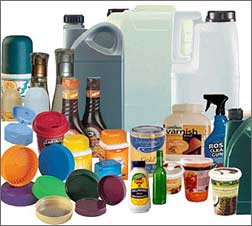Cosmetic Packaging Strategies
Cosmetics are all about good looks. That goes for their packaging, too--but
only up to a point.
No product segment has to pay more attention to packaging aesthetics than
color cosmetics and fragrances. But practical considerations can't be shoved
aside. And numerous factors--including pressure to cut costs, the need for
better product protection and the availability of high-performance
alternative materials--are making practical concerns more prominent than
ever.
Color cosmetics constitute a $7.8 billion market in the U.S. But the
economic slowdown as been as unkind to cosmetics as to other consumer goods.
Sales of color cosmetics enjoyed a compound annual growth rate of 6.1% from
1997 to 2002, but market analyst Euromonitor International projects a growth
rate of only 1.4% through 2007.
Plastic Packaging Techniques
In
response, cosmetics manufacturers are adopting various strategies to cut
costs. One of these is the use of plastic over glass--a substitution that
can bring other benefits besides economy. Function and cost is what drives
the conversion from glass to plastic. If there was one trend in terms of
those things that were in glass before, it's going to plastic because it
allows function that was never there in glass. Plastic has another advantage
over glass: Color. The options literally run the gamut of the rainbow with
plastic, whereas color choices with glass are more limited--and in general,
a colored glass container must be run in much higher volume than plastic.
Plastic is just about the only material that offers this kind of color
versatility. But some cosmetics marketers maintain that for certain
applications, especially fragrances, nothing but glass will do. But, you
can't create a plastic bottle that is as beautiful as a glass bottle. Some
companies are starting to use plastics for fragrances, but it just doesn't
look the same. With fragrances, aesthetics often outweigh practical
considerations, which helps make glass a popular choice. Fragrances usually
are not intended to be portable, which removes weight considerations, and
are not often used in the bathroom, which reduces the importance of shatter
resistance.
Cutting Cost for Glass
But cutting costs is important for glass applications, too. Even marketers
of high-end fragrances often wind up adopting cost-reduction strategies. A
bottle is less expensive when it has a less complicated design and lighter
weight--something that has to be decided at the early stages of design.
While glass prevails for fragrance bottles, their closures are being made
increasingly out of plastic, which represents a more economical alternative
to metal. Plastics must have certain properties before they can be used for
fragrance packaging.
Material Savings 
Substituting less costly materials is a time-honored strategy for reducing
expenses. For example, Mary Kay had been using a palladium-coated closure
for its Journey cologne. As a cost-savings measure, Mary Kay recently
switched to white bronze. You can't tell the difference unless you really
look at it hard. According to the experts, Substitution works best for
established products that have built up a base.
The use of stock containers, as opposed to custom, is another
cost-reduction strategy.
Of course, cosmetics packagers have practical concerns besides cost.
Physical protection is an increasingly important factor. Many cosmetics
offer hydrating benefits by using higher proportions of water in the
formulation; for such products, airtight packaging is vital.
A number of lipsticks, especially ones with silicone-based formulations,
require added moisture protection, says Tom Holloway. That might have to be
accomplished with an additional component such as a round polypropylene seal
underneath a square cap. For other products, such as mascara, added moisture
protection might take the form of thicker bottle walls. A typical mascara
bottle might have walls 0.035-inch wide; a water-rich formulation could
require walls as thick as 0.07-inch. Doubling the thickness slows down
bottle production and constricts the design.
The balance between aesthetics and practical concerns is perhaps more
delicate for cosmetics than for any other consumer products. But a soundly
conceived design strategy with the right materials can strike that balance
in a way that will greatly increase consumer appeal.


 Substituting less costly materials is a time-honored strategy for reducing
expenses. For example, Mary Kay had been using a palladium-coated closure
for its Journey cologne. As a cost-savings measure, Mary Kay recently
switched to white bronze. You can't tell the difference unless you really
look at it hard. According to the experts, Substitution works best for
established products that have built up a base.
Substituting less costly materials is a time-honored strategy for reducing
expenses. For example, Mary Kay had been using a palladium-coated closure
for its Journey cologne. As a cost-savings measure, Mary Kay recently
switched to white bronze. You can't tell the difference unless you really
look at it hard. According to the experts, Substitution works best for
established products that have built up a base.